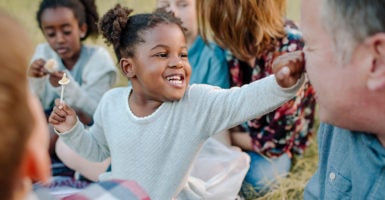For the past 16 years, Herbie Newell has been president and executive director of Lifeline Children’s Services, an Alabama-based organization that serves vulnerable children around the world. Newell shares his views on the child welfare system, how his organization approaches finding homes for kids in need, and how it trains and equips parents who want to adopt.
Newell also discusses Lifeline’s international outreach, (un)adopted, a program that helps children in their home country. Through the powerful real stories of these children, he explains how kids are being equipped for successful futures.
Whether you’re looking to adopt or not, you can learn more about how to be a part of changing the lives of vulnerable children at Lifelinechild.org. But begin by reading the lightly edited transcript below or listening to the podcast:
Virginia Allen: I am joined on The Daily Signal Podcast by Herbie Newell, president and executive director of Lifeline Children’s Services. Lifeline is an organization that supports families through adoption, family reunification, counseling, training, and more. Herbie, thank you so much for joining me.
Herbie Newell: Oh, it’s a privilege. Thanks for having us and allowing us just to have this important discussion about child welfare.
Allen: Absolutely. So you’ve been the executive director of Lifeline since 2003 and you have really worked hard over the past 16 years to broaden the work of Lifeline to help even more children. So can you explain a little bit about just how you go about connecting children with families … whether it’s in the case of adoption or foster care, how do you bring those individuals together?
Newell: First, and this is, I believe, what has been a big … part of the growth that we’ve seen in the ministry over the last 16 and a half years, and that is really identifying the children who are in need.
I think a lot of times … a family has a desire or they have a calling to take care of a child and then you kind of start with, unfortunately, at times, what kind of child are you looking for? What are the specifics of a child’s background that you’re looking for?
And really what we’ve tried to focus on the last 16 and a half years is not necessarily what is a family looking for, but truly what are the children in need of, and then going and recruiting families that can meet the needs of that child.
That has been really with just a lot of diligence and hard work, both internationally and here at home. It’s sitting down with child welfare providers in every state that we’re working in and saying, “What are the children with the biggest need, that if you could have a family for this child or these children, that would make your day or make your week?”
And then the same thing as we travel internationally. [We’re] meeting with the central authorities and saying, “Who are the children that are available for adoption who probably are not going to find permanence here in your own country, that you would say go to the top of the list of ‘these are the children that we have the most need for’?”
Now, certainly, we want to also ask them, “Are there others that are in that same category?” But we want to advocate for those children and for those needs. And I think it does a lot of things. One, it helps truly find the children who have the biggest need of families. But then it also really sets expectations for families who are looking.
Because a lot of times … on our state child welfare in foster care or from adopting from foster care, folks get frustrated and they [say], “I’ve been in the process for a long time, I hear there’s all these kids that are waiting. But I can’t seem to be matched with one of these children.” And a lot of times I think it’s because we have such a narrow focus on the child that we’re available for, and that’s really how we’ve tried to switch it in the last year.
Allen: That’s such a very strategic approach and really smart. So have you seen that there has been an increase in the number of children entering the foster care system and in need of adoption over, let’s say, the past 16 years that you’ve been involved in Lifeline or has that number actually decreased?
Newell: I think the number of kids in care has stayed pretty consistent. The number of kids that are available for adoption has certainly increased.
Unfortunately, though, in the same 16 years you’ve seen, and I don’t want to say unfortunately, [but] unfortunately, for the kids here in the United States, you’ve seen the same amount of families that have been willing to adopt. And a lot of those have adopted harder-to-place children, have adopted teenagers, and have adopted kids with some pretty severe special needs internationally. While a lot of those kids here in the United States have continued to languish in care.
So I think that our child welfare system [can] certainly have maybe a different approach. They are taxed, they don’t have the resources that they need. And so, unfortunately, it’s not necessarily that there aren’t more kids that probably don’t need the attention of our child welfare system, we just don’t have the resources to go and seek out and really help some of these kids that are in need.
So that number [of families willing to adopt] stayed consistent. But definitely I’ve seen more and more children that are in the need of permanence through adoption.
Now, the other thing with our child welfare system, and this is not at all throwing stones at the people who make up the child protective services, but it is to say the process is so long for a child who goes into care to finally get to the point where their parental rights had been terminated and they’re available for adoption.
And unfortunately, many times those children have had traumatic experiences jumping from one foster home to the next or they’re just a whole lot older. And unfortunately, also a lot more embittered because of this process. And not having someone that they think is seeking after them.
So it is a harder process to adopt a child from foster care, but there are definitely a lot more children in need today in the U.S. system that need homes, that need moms and dads who are realizing that they’re bringing in the suffering and the pain and the hardship of these children. And who realize that it’s going to be a long journey.
But if you look at our country, if we don’t aggressively do something good for these children, they’re languishing in foster care [and] need permanency. If we don’t wrap around them with families, then, really, unfortunately, the statistics are true. They’re just going to end up in our juvenile justice [system] or they’re going to end up in our criminal courts without families.
And I know families have adopted these older children. I know families have adopted children that have been harder to place out of our system and a lot of times these children do have a lot of trauma.
They do act out, they do end up in juvenile justice anyhow. The difference, though, is you have a family that’s fighting for them. You have a family that’s wrapping around them and when they’re released, they have a family that’s waiting for them, and that’s a big thing.
I believe it can actually start to transform a lot of the broken places in our society if families would say, “It’s going to be hard, it’s going to be difficult, but I’m willing to step [up] and wrap around a child in need here in our system.”
Allen: At Lifeline, you all have been so strategic, both internationally and domestically, about really trying to walk with families through the adoption process. You support them so that, let’s say, if they do want to adopt an older child and they’re meeting some of those barriers and those challenges of a child coming into their life and having baggage, you all really try and support them. Can you explain a little bit about how you do that?
Newell: Well, one of the things that we want to look at as we see any family that’s called to adoption, especially adopting a harder-to-place child, an older child, is they need preparation. And the way that we would tell a family—because, unfortunately, a lot of times the families come in and they think, “Well, I’m just uniquely qualified and I can do this.” Like, “I’ve got everything that I need.”
But the truth of the matter is we wouldn’t travel tomorrow to Bangladesh, for instance, this country in South Asia, and not prepare and make sure our passport is ready, not get ready to know what do they speak, what kind of language did they speak? Where are we going to stay? We make plans if we travel.
You’re about to go [to] a destination and [on] a journey with a child that’s a lifetime destination and a journey, and there’s no way that you can be completely prepared. But we need to make sure that you have all the tools in your tool bag and that you’re packing up, in a sense, your briefcase, your luggage, so that you have some tools to be able to help those children.
What’s funny is, a lot of times on the front end, the family is resistant to the training. But what we have found is if we can equip them as much as possible, if we can give them as many resources as possible, they’re not going to remember it all. It’s going to fail them in some regards, because once the road hits and the child’s in their home, they’re going to forget some of those things. But … we could put little markers in their brain to say, “Ah, I think I remember this from training.”
And then we want to be there also, not just to prepare families on the front end, but to walk with them on the back end. Because what we realize is this is a journey and it does bring complexities.
In the same way today, somewhere in our country, someone’s giving birth to a child with Down syndrome. And they may not have been ready for it, but they probably looked into it. They probably got ready for what that looks like, but they’re also going to need help throughout their entire growing and rearing this child.
What you really hope to do to prepare that family, who knows they’re about to give birth to a child with Down syndrome, in all of the things that they’re going to need. They’re not going to remember them all, but they’re going to be markers so that when they experience something, when heart issues come, [and] most folks that live with Down syndrome are going to have some type of heart issues, … they’re reminded, “Oh, that’s why I have that cardiologist. That’s why I go there.”
That’s the same thing we’re trying to do with families, is give them as much training [but] not overwhelm them, not to bog them down, but enough training that we’ll put little markers in their brain to say, “I remember I heard about this.”
So they’ll go seek the resources that they need so that they won’t give up and they won’t get frustrated, but they will continue to thrive and survive with that child.
Allen: That’s great. And many people are just hesitant to pursue adoption because all they really heard is that it’s really expensive and there is a ton of paperwork involved. What would you say to those individuals that maybe would think, “Well, I’d love to adopt, but it just sounds way too difficult.”
Newell: Well, first and foremost, I would say, unfortunately, it is difficult, right? And there is a lot of paperwork and there is a lot of expense that goes with it. The good news is there are people to help you with that.
So there are a lot of grant agencies that actually today, sitting here in 2019, actually have more money than they have families to give that to. And so if you will do your research and do your homework, there are a lot of organizations that want to help defray that cost.
The federal government gives [to] most adoptive families, especially if they need it because the phase-out income requirements are for those who would need the tax credit. There are tax credits to help defray that cost.
But what I would say is, again, there’s always a cost to what we do in life and there’s so much unfortunate red tape in that. And at one point you can look at it and say, “Why all this cost? Why all this red tape? Why all these organizations that seem to (as a family might say) just want a piece of this pie? They just want a piece of these dollars. Why are we having to pay all these different people just to do something good, to do something noble by bringing a child in need into our home?”
And unfortunately where there are vulnerable children, there also lives corruption. And because of those corrupting practices there’s so many organizations, so many safeguards, to make sure that this child really is orphaned, that this child really doesn’t have parental support, and that this child really is getting the care that they need until they come into that home.
And again, group homes, orphanages around the world, are a whole lot more expensive to operate than our own homes. So the care sometimes of these children is costly. The care of putting these children through school or helping these children to where they are, it is costly.
Then, of course, if you’re adopting internationally, you have travel expenses. The good thing—and I’ll put another plug in about the system—is adopting out of foster care is currently without costs outside of the legal costs. So you don’t have to necessarily have a fee to your child welfare department or your county in order to adopt. That is all underwritten by child protective services.
So if cost really is something that a family is thinking about, maybe to defray, [and] they don’t know how to defray that cost for intercountry adoption, they can always adopt from foster care and that cost is very much less than other adoption.
Allen: Let’s take a moment and talk a little bit about your work internationally.
On your website you report that there are over 153 million orphans around the world today, but less than 1% of these children will ever have the opportunity to be adopted. In response to this really sobering reality, you all launched the (un)adopted program and that’s to help children specifically right where they are, in their country of origin.
Can you just explain a little bit about the (un)adopted program and what you all do and how it works?
Newell: So really what we looked at is, and UNICEF puts these numbers out, there’s 153 million orphans. And I know a lot of times, even today, we don’t like that word, “orphan.” And we have connotations that we think that go with that word. Well, that means that they’ve lost both parents to death or dismemberment. And really what orphan means is a child that is without proper parental support, without proper support from the community.
What we’ve found as we’ve traveled around the world is, yes, less than half of 1% of these children can be adopted. And so many times these children don’t necessarily need to be adopted. They’re plugged into their community. They just are lacking that parental support.
So what we really felt like is we need to come around and not just institutionalize these children, put them in more institutions, but how do we raise up the community—and for us, specifically, the local churches in their community—to wrap around these children, to love on them, to care for them, and to teach them the life skills and the job skills that they need in order to grow into maturity? …
Over my last 16 years that I’ve seen, there’s a lot of people doing a lot of really good things for vulnerable children, orphans around the world internationally. But so many times we look at that child that’s 2, 4, 6, and we say we need to put them in a home. We need to put them in a place that’s safe. But we’re not making future plans for those children the way we would make for our own children.
I have three children and have a child that’s about to be 15 years old, and I’m thinking already as [he is] a freshman in high school, “What are we going to do for college? What are we going to do? How do I encourage him to start thinking about the next steps? He’s got to start thinking about what does it look like for adulthood? What does it look for maturity?” And there are already ways that I’m training him up.
This weekend we went on a trip and we were able to borrow someone’s car. And after I borrowed their car, filled it up with gas, I’m thinking: “You know what? I need to make sure my children know, if you borrow something from someone, make sure you leave it better than the way you found it.”
And so there’s all these things that as we go along the way, I’m teaching them, hoping that one day when they become an adult, when they’re out on their own, they’re going to remember these skills. They’re going to go back to those values that we’ve instilled in them.
But a lot of times internationally, especially as we do aid around the world, we only think about today. We think about, “How do we make sure they’re fed? How do we make sure they’re clothed? How do we make sure they’re safe?” But [if] we’re not making those plans for when they’re 18, when they’re 19, what are we going to do?
That’s really what (un)adopted is all about, is saying for this 99.5% of kids that are vulnerable and they live in their countries of origin, how do we aggressively wrap around them to prepare them for what it looks like when they’re no longer a child, but they’re now an adult?
And how do we get them to not just understand that there’s going to be a day where they’re going to age out of an institution, but how do we prepare them to say, “This is how I’m going to make better my community, this is how I’m going to make better my country,” and really see them as those that could … change the trajectory even of their communities and their neighborhoods and their countries?
Allen: That’s so great. Could you share a story of a child or a family that you’ve worked with that you have seen, “Wow, this really works”?
Newell: There’s a little boy, his name is Adam, and he’s actually in Uganda. And he’s the first one that comes to mind just because I was there this summer and saw so many of the things that he’s doing. … Adam is profoundly deaf. He lives in a Muslim community in Uganda.
But this local evangelical church had started a tutoring program, which has become a school now for these deaf orphans that were living on the streets or living with strangers in the community. And Adam was one who has gone through the school.
He’s come through the school and … we have a computer lab at the school [where] he really took to [the software application] AutoCAD. And so one of the things that Adam is doing already is getting classes now to become an architect.
It’s been neat as well to see Adam also grow in maturity and leadership. Now, he’s leading a Bible study for other deaf members in the community. He’s taking a lead in things.
So I met Adam for the first time nine years ago and I remember he didn’t know how to sign. He didn’t really have much identity. … I believe he’s 11 years old, and he really just didn’t have a belonging. And there was a sweet family, a sweet lady and her daughter, who were helping him, feeding him, taking care of him.
But now to see Adam with dignity, to see him as a leader, to see him with language that he can sign, but also to see him now with a hope and a future. And that in nine years to see the difference between just trying to feed him and keep him warm and comfortable … [and] really aggressively pouring into him.
The pastor at the church, their pastor, Raphael Kujubi, meets with Adam, disciples Adam, is talking to Adam about, “This is what it looks like when you get a job. You’ve got to be there on time. You’ve got to do these things. You’ve got to aggressively do something good.”
And the neat thing is here’s a deaf kid who would have potentially had no hope and no future. And now with so much growth that’s happening throughout Africa, they need architects, they need folks that are well designed.
Adam, because so many of his senses are not acute because of his deafness, he’s had other very acute senses. And being able to learn computer skills and being able to pick up on things a lot more quickly has been just something that has really ushered him ahead.
And then, quickly, I also think of these two boys as well in Togo who were growing up, and again, they’re growing up in an orphanage and by coming around them with this local church, they’ve now learned.
They’re twin boys. One is doing compost and he’s actually growing grain and wheat and the other is doing chickens, and they’re working together to help each other’s business. So Winner is using the compost from Godwin’s chickens and Godwin is using the grain from Winner to be able to take care of his chickens.
And so these are just two of the things. I could tell so many stories, but [it’s about] aggressively seeing children’s lives be changed. And again, not just what are we going to do today, but really thinking futuristically in planning and dreaming with these children to say, “This is something that you could aggressively do.”
And for us as a Christian ministry, we never detach that from a local church because we know that as Americans, as a foreign NGO in their country, … we’re not going to be there forever. But these local churches in some semblance will be there to wrap around these children.
Allen: Now, we could spend hours talking about all the programs that Lifeline provides from family restoration to counseling and education. We don’t have time today to get into the weeds of every program. So I want to give you the opportunity to share a little bit about where we can find more information about all the services that Lifeline does offer and how we can go about getting involved, and even partaking in some of those services or getting assistance with adoption.
Newell: It’s really easy. If you want to get connected with us, you go to Lifelinechild.org. And then we’ve made it really easy on social media as well. Pretty much any social media platform you have, you look for Lifeline Child. And so that’s Lifelinechild.org or Lifeline Child on Facebook, Instagram, Twitter, whatever other social media networks that you may happen to be on. We’re pretty much on most of them as Lifeline Child. …
As we close, I just want to also put a plug in that … not everyone’s called to adopt. And not everyone’s called to do something internationally. But you mentioned just a minute ago family restoration, and I do believe as we started with foster care, a big component that’s missing from our child welfare system is, how do we reunify these children back with their families?
Because a lot of the reason that some of these children are not available for adoption is that their families are doing just enough to keep them in the system, but not enough to get them back into their homes.
And I believe, as those that are conservative and those with faith, there’s so much that we can do to aggressively wrap around these families.
So not everyone is called to adopt a child out of foster care, but we can all do something to aggressively help our child welfare problems that we have in our country and around the world.
And again, if you want to get involved or know how to get involved or know how you could start to do something in a community, you can go to Lifelinechild.org.
Allen: Herbie, thank you so much for your time today. I really appreciate it.
Newell: Absolutely. Thanks for having me.
































